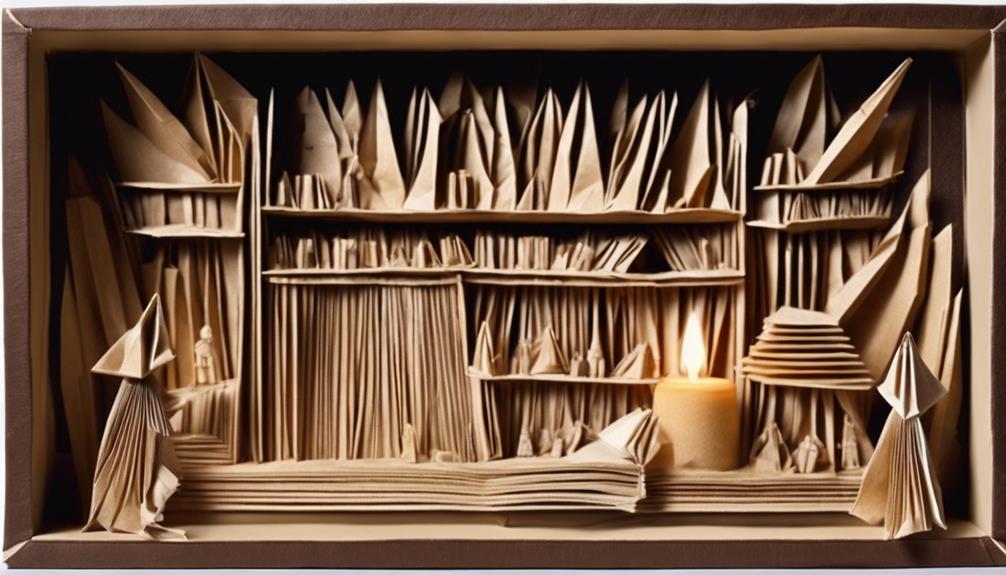Public art in India's urban spaces enriches community identity and inspires social engagement. From vibrant murals in the Lodhi Art District to powerful installations addressing social issues, such art transforms public areas into cultural hubs. You'll find that it reflects local traditions, promotes discussion, and enhances the aesthetic appeal of cities. Economically, public art attracts tourism, invigorating local businesses and creating jobs for artists. However, challenges like vandalism and funding constraints can impact these projects. As you explore further, you'll uncover more about how public art shapes urban environments and community ties in India.
Key Takeaways
- Public art in India fosters community identity by reflecting local traditions and histories through accessible sculptures, murals, and installations.
- Initiatives like the Lodhi Art District and Kala Ghoda Arts Festival enhance urban aesthetics and stimulate economic activity through tourism.
- Collaborative street art projects encourage social dialogue and engagement, addressing pressing social issues and inspiring community pride.
- Legal challenges and limited funding hinder the preservation and appreciation of public art, impacting artists' creative expression and vision.
- Public art transforms urban spaces into cultural hubs, promoting inclusivity and enhancing the overall quality of life for residents.
Historical Context of Public Art
Public art in India has deep roots that trace back to the early 20th century, particularly through the pioneering works of artists at Santiniketan, like Nandalal Bose and Benode Behari Mukherjee.
These artists laid the foundation for community-engaged artistic practices that intertwine Indian art with cultural identity. Their efforts set a precedent for future public art projects, transforming urban spaces into platforms for artistic expression. This evolution mirrors trends seen in contemporary art where artistic expression evolves in response to societal changes and cultural dialogues.
Post-independence, the Indian government adopted a 2% budget policy in the late 1950s, mandating that public buildings allocate funds for permanent murals and artworks.
This initiative greatly promoted public art initiatives, leading to notable works like Devi Prasad Roy Choudhary's Eleven Sculptures and MF Husain's Bharat Bhagya Vidhata, which illustrate the evolution of art in public domains.
In contemporary art, artists like Ravi Agarwal and Atul Bhalla tackle pressing social issues, using their works to spark conversations about ecology and social justice.
Events such as the Kala Ghoda Arts Festival revitalized urban spaces, showcasing both traditional and contemporary artistic expressions.
This historical context demonstrates how public art in India continually engages with community needs while reflecting broader social narratives.
Definition and Characteristics

Art in urban environments takes many forms, with large-scale sculptures, murals, and installations often transforming public spaces into vibrant cultural hubs. Public art is defined by its accessibility, allowing everyone to experience and interact with it, unlike traditional art confined to galleries. Its core lies in site-specificity; local artists often choose materials and themes that resonate with the unique attributes of the location, fostering a deeper connection between the artwork and the community.
Additionally, public art can enhance cognitive development and promote social interaction, similar to how play encourages social skills.
Public art serves as a canvas for expressing cultural narratives and community identities. Through these installations, you can witness reflections of local traditions, histories, and shared experiences. This creates opportunities for social engagement, inviting dialogue and participation among residents and visitors alike.
Moreover, public art enhances urban spaces, not just visually but also by promoting a sense of ownership among the community. When you engage with these artworks, you're not merely an observer; you become part of a collective experience that celebrates diversity and creativity.
In principle, public art enriches our cities, making them dynamic places where culture and community thrive together.
Social and Cultural Impact

In urban India, public art plays a significant role in shaping social and cultural narratives. It serves as a powerful medium for addressing social problems, reflecting the realities faced by local communities, especially the youth grappling with issues like systemic poverty and social fragmentation.
Initiatives like the Lodhi Art District and Sassoon Dock Art Project showcase how public art can rejuvenate neighborhoods, enhancing urban design and fostering a sense of community pride. The emotional highs and lows depicted in public art can resonate deeply with individuals facing personal struggles, similar to the experiences of those encountering BPD-coded characters.
Artistic expressions in these public spaces prompt dialogue around social movements, allowing residents to engage with their surroundings in meaningful ways. Collaborative street art projects not only beautify the city but also reinforce social cohesion, as they evoke varied emotional responses and encourage shared experiences among community members.
Moreover, the visibility of street art is amplified through social media, broadening its reach and enabling urban culture to evolve dynamically. As you explore these vibrant installations, you'll notice how they contribute to a stronger collective identity, making public art an important element in the social and cultural fabric of India's urban spaces.
Economic Contributions

Exploring the economic contributions of art in urban India reveals a vibrant landscape where creativity fuels growth. Public art serves as a catalyst for economic activity, not just beautifying the urban landscape but also invigorating local economies.
For instance, cities that embrace innovative art forms, such as mushroom coffee benefits, often see a boost in community engagement and creative tourism. Here's how:
- Tourism Boost: Public art attracts visitors, increasing foot traffic and spending in nearby businesses.
- Local Artists: Commissioning public artworks provides professional opportunities for local artists, fostering a thriving creative environment.
- Cultural Infrastructure: Investment in public art enhances a city's brand, making it more attractive to investors and new businesses.
- Property Values: Neighborhoods with significant public art installations see increases in property values, aiding urban revitalization.
- Art Festivals: Events like the Kala Ghoda Arts Festival generate substantial economic activity, promoting local culture and engaging the community.
These elements highlight how public art not only enriches the cultural fabric of urban areas but also stimulates economic growth, making cities more dynamic and appealing.
Challenges and Limitations

When you explore public art in India, you'll quickly notice that vandalism and deterioration pose significant threats to these valuable cultural expressions.
This is akin to how certain environmental factors can affect the health of animals, as seen in the cat health and weight management discussions.
Legal restrictions can further complicate the situation, often limiting the creativity artists can bring to urban spaces.
It's clear that addressing these challenges is essential for preserving the integrity and vibrancy of public art.
Vandalism and Deterioration Issues
Public art in India often battles a harsh reality, facing rampant vandalism and deterioration. You might notice that many artworks suffer from defacement or destruction, primarily due to a lack of protective measures and public awareness. Environmental factors like pollution and weather conditions also greatly contribute to the degradation of these pieces over time.
Additionally, the psychological impact of vandalism can discourage artists from creating new works, much like how false positives can affect women's mental health in the context of breast cancer mammography and older age.
Here are some key challenges:
- Vandalism often leads to irreversible damage, undermining the artist's vision.
- Environmental factors accelerate deterioration, making preservation efforts more critical.
- Limited funding and institutional support hinder maintenance and repair initiatives.
- Landmark cases, such as the destruction of Amar Nath Sehgal's work, highlight the need for better protection of artists' rights.
- Criminal activities, including the theft of artworks like Anjolie Ela Menon's murals, expose the vulnerability of public art in urban environments.
Despite these challenges, the preservation of public art is essential for maintaining cultural heritage and promoting community engagement.
Addressing these issues requires a collective effort from artists, local governments, and the public to foster a greater appreciation for the value of public art in urban spaces.
Legal Restrictions and Regulations
The challenges surrounding public art in India extend beyond vandalism and deterioration to encompass complex legal restrictions and regulations. Legal frameworks governing street art vary greatly across states and cities, imposing strict penalties for unauthorized graffiti, including fines or community service. This creates a climate where street artists often feel stifled in their creative expression.
Furthermore, the lack of a diverse portfolio, such as a diversification of retirement portfolio, can be mirrored in the public art scene, where artists may feel compelled to conform to mainstream expectations rather than explore innovative, risk-taking projects. When collaborating with government bodies, many artists find themselves shifting from provocative graffiti to more sanitized, non-offensive styles, which can dilute their original vision.
The lack of clear guidelines complicates matters further, leaving both street artists and property owners confused about what constitutes acceptable public art. This inconsistency in enforcement of regulations only adds to the frustration.
Recent movements advocating for the legal recognition of street art emphasize the need for formal policies that safeguard artists' rights while addressing community interests. However, the shift from unsanctioned graffiti to commissioned works raises important questions about artistic freedom.
As artists navigate institutional controls and property owner expectations, they often sacrifice their voice in favor of compliance. Balancing the need for regulations with the desire for creative expression remains a vital challenge in shaping India's urban public spaces.
Successful Public Art Examples

Numerous successful public art examples across India highlight the transformative power of creativity in urban spaces.
These projects not only beautify areas but also foster community engagement and cultural appreciation, often blending elements of design thinking to address local needs and inspire participation.
Here are a few standout initiatives:
- Lodhi Art District, Delhi: Over 50 vibrant murals created by Indian and international artists have turned the district into a cultural hub, attracting art lovers and tourists alike.
- Sassoon Dock Art Project, Mumbai: This initiative revitalized a historic fishing dock, blending traditional and contemporary art while involving the local fishing community.
- Kala Ghoda Arts Festival, Mumbai: Since 1999, this annual festival showcases public art installations and street performances, drawing hundreds of thousands and enhancing cultural appreciation.
- Fearless Collective: A grassroots initiative that addresses social issues like gender-based violence through impactful murals, fostering community dialogue across various cities.
- 48°C Public.Art.Ecology Festival, Delhi: This festival engaged local communities in environmental discussions through site-specific works, highlighting public art's role in raising awareness and social engagement.
These examples illustrate how public art can transform urban spaces, connect communities, and address social issues creatively.
Frequently Asked Questions
What Is the Role of Public Art in the Urban Spaces?
Public art shapes urban spaces by reflecting community identity, enhancing aesthetics, and fostering interactions among residents. It creates memorable landmarks, supports local artists, and stimulates economic growth, ultimately enriching the cultural fabric of your environment.
What Is the Role of Street Art in Urban Space Recognition?
As the saying goes, "a picture's worth a thousand words." Street art helps you recognize urban spaces by creating visual landmarks, fostering community pride, and transforming forgotten areas into vibrant hubs that resonate with your experiences and memories.
What Is the Public Art of India?
Public art in India showcases vibrant sculptures, murals, and installations that reflect local culture. You'll find these works in urban areas, engaging communities while celebrating diverse narratives and artistic expressions that enrich everyday life.
What Role Does Street Art Play in Urban Environments?
Street art's like a rebellious teenager, throwing paint cans at society's issues, while urban spaces become its canvas. You see local stories unfold, sparking conversations and evoking emotions, turning dull walls into vibrant dialogues.
Conclusion
In India's urban spaces, public art plays a pivotal role, transforming dull districts into dynamic destinations. It sparks social synergy, celebrates cultural diversity, and fuels economic growth. Despite facing challenges, the charm of enchanting murals and installations continues to inspire communities. By supporting and promoting these artistic expressions, you can contribute to a vibrant visual tapestry that enriches everyday experiences. Embrace the beauty of public art, and watch as it weaves together the fabric of your city.









